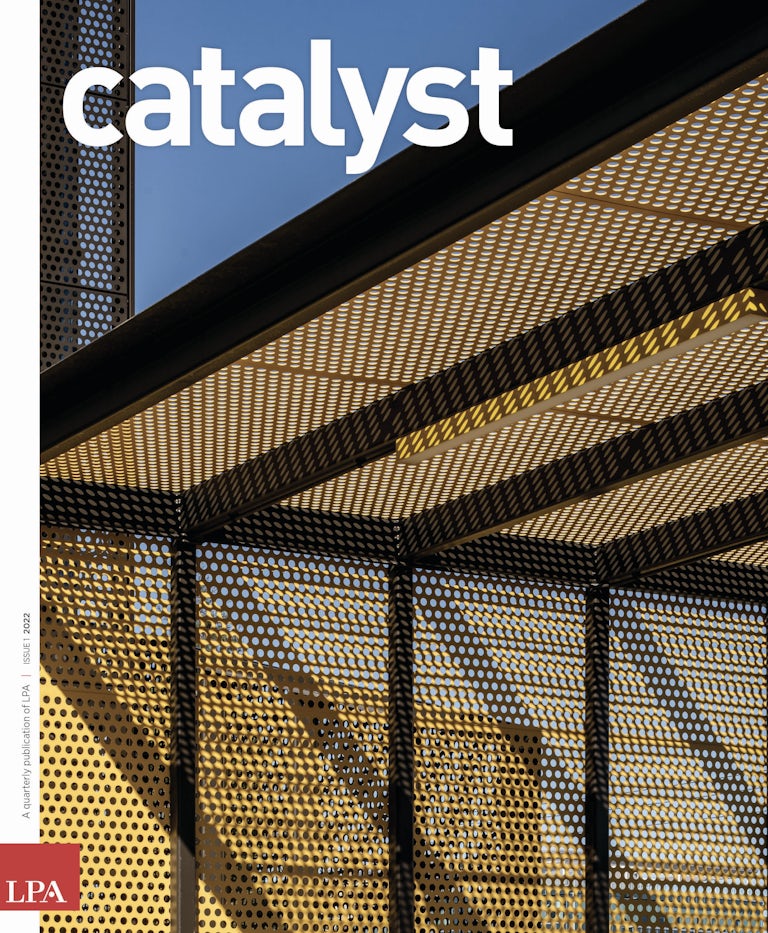Global biotechnology company Vertex Pharmaceuticals is on the leading edge of developing transformative medicines for people with serious genetic diseases. Their lab facilities support the health and wellness of scientists and researchers, as well as their life-saving work.
LPA worked with Vertex on the design of its 170,000-square-foot research facility in San Diego, which reflects many of the company’s philosophy about an integrated workspace, connecting science to patients and providing outdoor spaces to support the team.
LPA Managing Director Eric Jones and Director of Lab Planning Isabel Mandujano recently spoke to Vertex Senior Vice President Paul Negulescu, PhD, and Tamara Fox, Director, Environmental, Health and Safety & Sustainability, about the evolving lab workplace, the effectiveness of their new facility and the evolution of their scientific work.
Eric: What is most important to your employees these days?
Paul: COVID-19 challenged conventional thinking about many aspects of our work environment. What we are hearing from employees is that they want flexibility, and we have empowered our staff to determine how to work together to use the facility to meet our goals.
Eric: What do you like best about your facility? Would you change anything to improve the experience for your staff?
Paul: What I like best is that the facility is a thoughtful reflection of our commitment to science and multidisciplinary research. The open design intentionally promotes interaction and collaboration. The designers removed a lot of doors and walls that one would find in a traditional lab design and activated the hallways by blending them with labs and office areas. This created neighborhoods with multiple departments that promoted a feeling of connection without needing to force connection in meetings.
Tamara: And we were really fortunate to leverage the outdoor space. I think in many ways that was a saving grace during this entire period. We have the space to accommodate more than 100 people, especially during lunchtime. The space allows us to gather and allow social distancing to ensure the health and safety of our staff and, as important, to continue to foster our sense of community.
Eric: How have these “neighborhoods” impacted the way the facility is used and the way people collaborate?
Tamara: With the mixture of science that goes on in the building, there’s a lot of traversing between floor levels and different groups. Let’s say you’re a chemist; the location of analytical labs and other support areas requires people to traverse the building to go to utilize required resources. Or if you’re a biologist, your experiment is not limited to what you’re doing in your particular lab. Even though it may seem incongruent or inefficient on paper, it really does support the collaborative nature of this facility. It forces people to move throughout the facility in a way that supports collaborative interactions with other groups and team members.
Eric: You prioritized interaction and collaboration, but at the same time you made the labs more efficient. It’s not just walking for walking’s sake.
Tamara: All of the infrastructure that supports their daily needs in the lab — for example, the automated solvent-dispensing system and access to supplies — all of that is just immediately accessible within the laboratory. They’re not worrying about those items, those daily tasks.
Isabel: How has the adoption of new technologies such as AI machine learning, robotics and computational models affected how you do research and the physical space required to do your work?
Tamara: Not just necessarily robotics or automation. I think other platforms were accelerated. Some of our lab-of-the-future initiatives were prioritized, whether it was the exploration of the information management tools, engineering tools, and use of AI learning to help support people to work more efficiently and effectively.
Paul: Scientists are using more of their time to analyze data, as automated processes have freed up people to do more thinking work. We’re entering, I believe, a new phase of pharmaceutical research where the end-to-end research is much more integrated. Successful companies will be able to recruit and retain employees because they have ways for them to generate and use data more efficiently and effectively.
Isabel: Do you think more of your scientists will be working side by side with machines?
Paul: Well, I think we’re among the more highly automated research labs, and it’s in our DNA as a site. What we’re seeing now with some of these tools is that scientists can be trained to configure their own systems — control the automation, use it, set it up themselves and then, on the back end, analyze and interpret the data themselves. As a result, we often have engineers, biologists and chemists working in shared labs.
This is an evolution of the workplace and why when we set up this facility, we mixed disciplines intentionally. We did not have a biology floor and a chemistry floor and an engineering floor. They were all mixed together to promote this multidisciplinary environment.
Eric: Do you think the facility has affected your overall recruitment and retention?
Paul: We’re really happy with this place. Visitors of all kinds, including potential employees, notice in the very first instant that there’s a community here and that this is a place that is working on science in the service of people.















